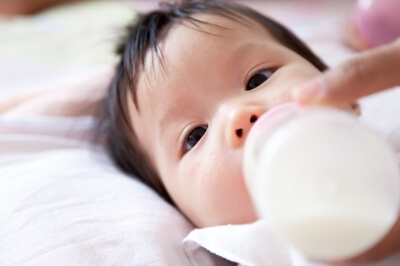Tips for Breastfeeding After A Cesarean

“We will have to do a cesarean” – these are words that almost no expectant mom is happy to hear. Having a baby is something that most women want to experience fully and consciously. We want to push and help bring our little one into the world.
But sometimes, there is no other way. At the end of the day, what every mom wants most is for her baby to be healthy.
Although a cesarean might at first seem like the easier option, for many women there is a catch: breastfeeding. It seems that when a woman gives birth by cesarean section, her milk takes longer to come in. According to experts, this is not due to the cesarean itself, but the hospital practices that often go along with it.
Breastfeeding after a cesarean
The first factor that may influence a mother’s ability to begin breastfeeding is that she is separated from her baby. Even today, after a cesarean section, mothers are separated from their babies, often for long periods. This means that early mother-child contact is absent, and breastfeeding is more difficult. But why?
For around two hours after they are born, babies can become lethargic. The best thing to do is to breastfeed them and then let them sleep deeply. From the very first moments, the child learns how to latch on and feed.
However, if the baby goes to sleep without having been fed, they will usually sleep for longer. When they wake up they appear unsettled. They have missed something that their instincts tell them is vital, even if they don’t know what it is.

Some hospitals therefore opt to bottle feed babies after a cesarean birth. But this can lead to problems breastfeeding later on, as latching onto a breast requires more effort than sucking from the plastic teat of a bottle.
The mother’s mobility after surgery can also cause problems. A cesarean section is an operation, and leaves a wound that will take time to heal. This can make it very difficult to find the right position to breastfeed a baby.
What tricks can help with breastfeeding after a cesarean?
A mother’s milk should normally come in within 30 to 72 hours after birth, whether this was natural, induced or by cesarean. This is a physiological process, which begins with the expulsion of the placenta from the body. Levels of progesterone drop, while those of prolactin, the hormone that leads to breastmilk production, increase.
It is not common for women to produce no milk at all after giving birth. In fact, low milk supply occurs in only 1% of women. So whether you have given birth by cesarean or not, even if your child cries, it doesn’t mean that your milk is not flowing properly. Many women believe that if their child cries during feeds, it is because they have not had enough milk and are hungry. But this is not always the case.

Here are some tricks for breastfeeding after a cesarean that have worked for some mothers.
- It is important to hold your baby to your breast as soon as you can. There are breastfeeding pillows that can help you to do this without putting pressure on the site of the cesarean. There are also certain postures that can make breastfeeding after a cesarean easier. Ask your doctor for advice. Getting your baby to suckle can help your milk to come in.
- Let your baby suckle whenever they like until your milk is flowing freely.
- If you can, ask not to be separated from your baby after the surgery. Try to get the nurses to give the child to the father, who can use skin-to-skin contact to keep them warm so they don’t expend energy on regulating their temperature. This will mean that they are close to you from the very start.
- If you are in pain, there are painkillers you can take. Your doctor can give you a prescription that is suitable for breastfeeding. Pain can stop your milk from coming in.
- Try to stay calm and relax. Fatigue and stress will affect milk production.
The fact that you had a cesarean does not mean that you will not be able to breastfeed your baby. As we have seen, many factors can complicate breastfeeding after a cesarean, but all of them have solutions.
All cited sources were thoroughly reviewed by our team to ensure their quality, reliability, currency, and validity. The bibliography of this article was considered reliable and of academic or scientific accuracy.
- Olza, I. Lactancia después de la cesárea. Hospital de Puerta de Hierro Majadahonda, Madrid. [Documento en línea].
- Perez-Escamilla, R et al. The Association Between Cesarean Delivery and BreastFeeding Outcomes among Mexican Women. Am J Public Health. June 1996. 86 (6): 832-836.
- Aksu A, Vefikulucay Yilmaz D. The relationship of postpartum sleep quality and breastfeeding self-efficacy of Turkish mothers. Scand J Caring Sci. 2019 Dec;33(4):833-839. doi: 10.1111/scs.12679. Epub 2019 Mar 13. PMID: 30866100.
- Shiraishi, M., Matsuzaki, M., Kurihara, S. et al. Post-breastfeeding stress response and breastfeeding self-efficacy as modifiable predictors of exclusive breastfeeding at 3 months postpartum: a prospective cohort study. BMC Pregnancy Childbirth 20, 730 (2020). https://doi.org/10.1186/s12884-020-03431-8.
- Gómez A, et al. Fármacos y lactancia materna. Protocolos Diagnóstico Terapeúticos de la AEP: Neonatología. Disponible en: https://www.aeped.es/sites/default/files/documentos/6_1.pdf.
- PINTO L FERNANDO . Apego y lactancia natural. Rev. chil. pediatr. [Internet]. 2007 Oct [citado 2022 Nov 09] ; 78( Suppl 1 ): 96-102. Disponible en: http://www.scielo.cl/scielo.php?script=sci_arttext&pid=S0370-41062007000600008&lng=es. http://dx.doi.org/10.4067/S0370-41062007000600008.
This text is provided for informational purposes only and does not replace consultation with a professional. If in doubt, consult your specialist.
